Disclosure: Meeple Mountain received a free copy of this product in exchange for an honest, unbiased review. This review is not intended to be an endorsement.
When was the last time you opened a game and were impressed with the components, like really blown away. Voidfall perhaps? Gloomhaven? Just about any game from Eagle-Gryphon games these days? So imagine my surprise and delight when I opened World Wonders, from Arcane Wonders–a $50 game with oodles of production value (at least in my opinion). Over 20 incredible wooden “wonders” (called monuments in the game, but each different and each with an impressive level of detail), dozens of cardboard tiles, a well designed and thought out insert, and an excellent rulebook–really one of the best I’ve read in quite some time.
But how does it play?
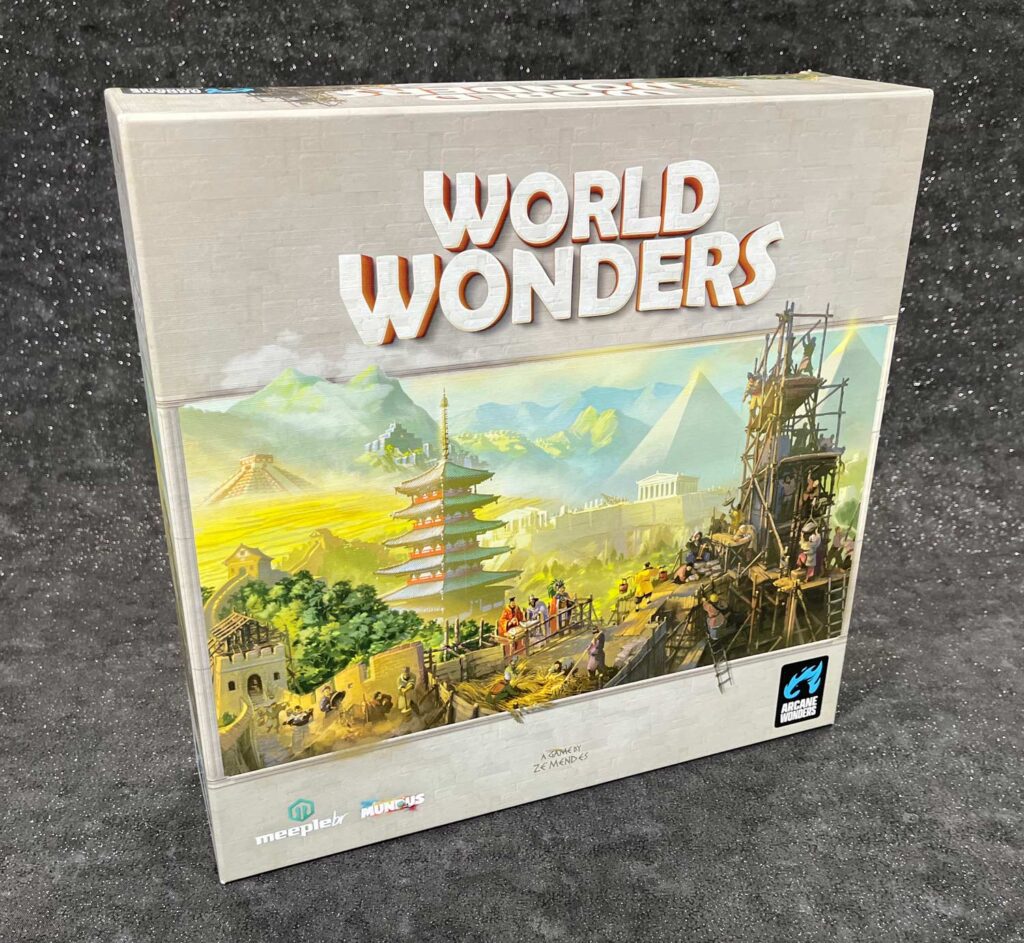
World Wonders Overview
In World Wonders, 1-5 players attempt to raise up their city / civilization, increasing their population, gathering resources, and most importantly…building monuments. The game ends after the tenth round, or when one player raises their population to twelve, although in my experience these two things usually happen very close together.
World Wonders is packed full of things you can do on your turn, which means that there’s always something useful to accomplish. Each player starts the game with 7 coins, and 0 each population, wheat, pottery, and engineering, marking them on their personal player board. Over the course of the game, you’ll continue to raise the latter four, while coins will reset at the beginning of each round. The end of the round is triggered when all players have spent their last coin.
Available Actions
So what can you do on your turn? Glad you asked.

Buy a Building Tile
Building tiles are at the heart of the game, and they come in 8 different polyomino type shapes, and five different colors. These tiles are the main way that you’ll gain resources, and they’ll also earn you points in several ways. Building tiles cost between 2 and 5 coins, depending on the size. Only one of each shape of tile comes out on each turn. Tiles not purchased by the end of the round are discarded.
There are some pretty specific rules about placement that you should pay attention to, but I’ll cover that in a moment.
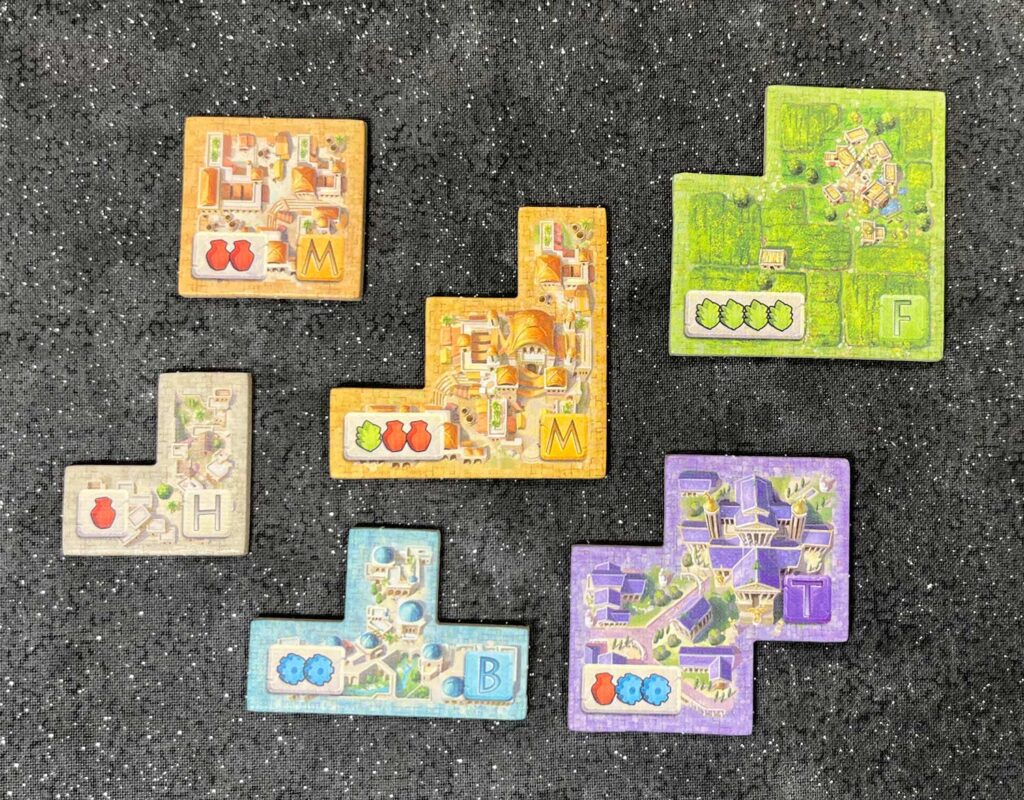
Buy a Road, or Roads
Roads connect various districts of your city, allowing you to stretch upwards and outwards from the bottom of your personal player board. They come in three sizes: one long one (which can also double as a bridge), a medium-sized one, and a tiny single square. Roads cost 1 coin.
Roads are crucial to your success in the game, but are also difficult to gain, because only three come out each turn. I’ll cover road placement at the end as well.
Buy a Tower
As already mentioned, placement rules are tricky, and a tower can be immensely useful because it allows you to start a road in a location you might not normally be able to. More on placement at the end. Towers cost 2 coins, and only one comes out each round.
Buy First (or second) Place
Turn order can be critically important; it’s essential in fact, if you want to make sure you grab a tile that you need. World Wonders is the first game I’ve ever seen which allows you to purchase both first and second place. Each of them costs 1 coin.
Buying a Monument
There will always be three monument cards available (unless all of them have been built). When a monument is purchased, it is immediately replaced. Placement rules apply here as well. A monument costs “the rest of your money”. This means that you could pay 7 coins, or just 1…but be careful waiting because other people are also eyeing the same monument as you.
Placement Rules
The placement rules aren’t hard, but they can be tricky to remember. In every game I’ve played, at least one player got them wrong, even near the end of the game. All the pieces you acquire will be placed on your personal player board. This board is double-sided, with one side featuring a lake in the center (this side is the same for each board), while the other side of the board features a river which runs from one edge to another (this side is different for each board).
Here are the placement rules in a nutshell.
Building tiles must follow one of these rules;
- Touch a road
- Touch another building of the same type (color)
Road tiles must follow one of these rules;
- Touch the bottom of the board (the “sidewalk”)
- Touch another road
- Touch a tower
-
- Notice that roads cannot be placed next to a building tile, even though building tiles can be placed next to roads.
Towers must follow this rule;
- Touch another piece that you have placed onto the board (building tiles, roads, or wonders)
-
- A tower’s only purpose is to allow you to extend a road outwards from a building tile or wonder.
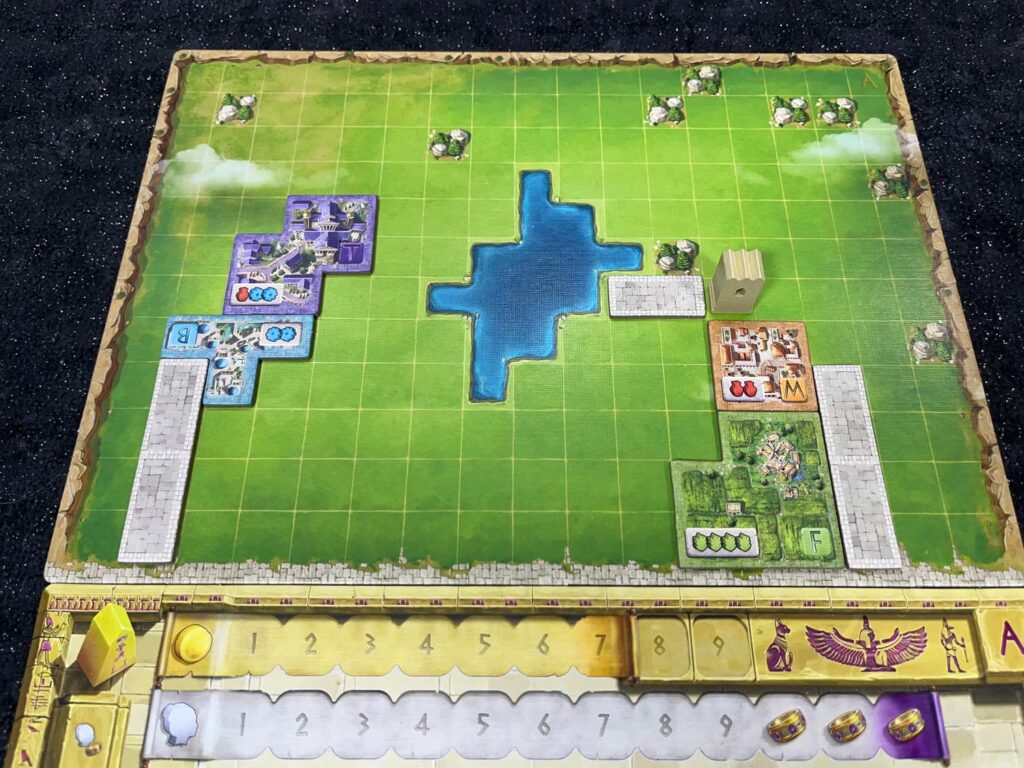
Each monument has their own set of placement rules, printed on their card. Let’s talk about some of them. Many monuments will display a road and a specific building color. This indicates the monument must touch both a road and that color building. Each monument card will also display a placement requirement (green space, water space, or either). For example, the Lighthouse of Alexandria monument is a single piece which must be placed next to a road and a blue tile, at least one of the four squares it takes up must be water, and the other three can be either water or grass.
The Great Wall of China monument is composed of three pieces, and has the following requirements. Each piece must touch another piece in the set (on an edge, not a corner), at least one of the pieces must be touching a natural resource space, a road, and a tan building.
Finally, some of the monuments don’t touch each other at all. The Moai monuments are also composed of three pieces, but they must be placed in a straight line (or a right angle), skipping exactly one space between each of the pieces. Additionally, one of them must touch a natural resource space, and one of them must touch a road.
Lighthouse, Great Wall, and Moai cards, with their monuments.
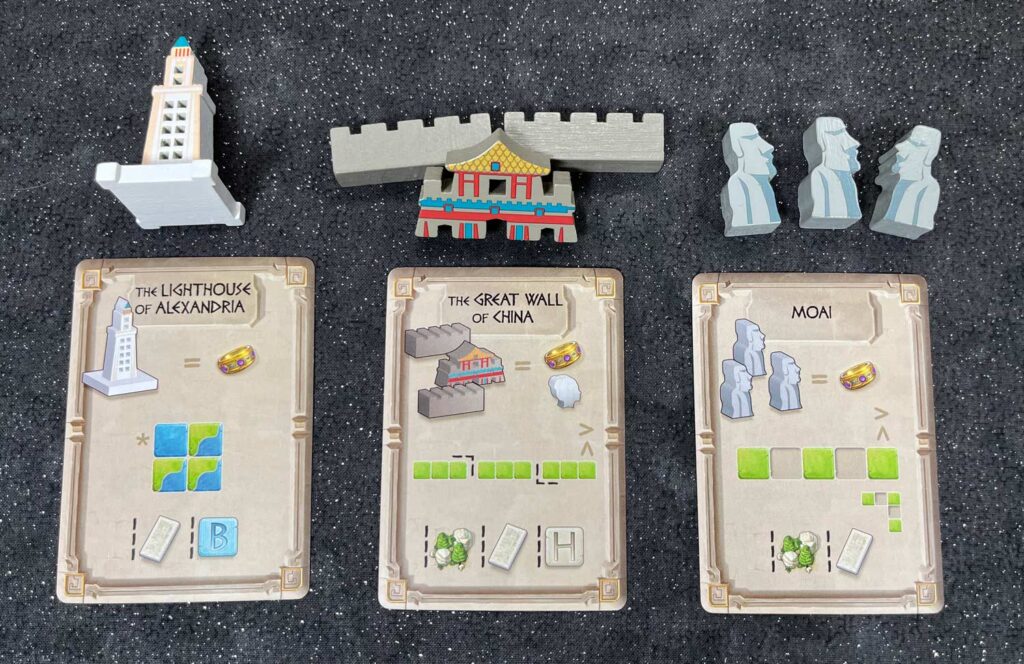
The time spent developing the placement rules of these wonders really helps the theme, especially as you learn more about the specific monument.
One nice thing about the monuments is that you can’t acquire one if you don’t meet the requirements. This prevents hate drafting, and more importantly means that attentive players can determine if anyone else can also acquire a monument they’re interested in.
Anatomy of a Turn
You’re going to talk about turn order a lot in this game. In the unlikely scenario that turn order isn’t purchased by one of the players, turn order is determined by the player with the lowest population, then fewest monuments, and then by previous placement. The importance of going first (or least second) in this game cannot be overstated. In a 3-player game there are only 3 road groups, 6 building tiles, and 1 tower which can be purchased. Additional building tiles are included for 4 and 5 player games, but still—going last can hurt.
I liken playing a round of World Wonders to playing chicken. You’re either going to claim the thing you want, straight out of the gate and damn the cost. Or you’re going to slowly spend one or two coins to see what other players are trying to do—hoping that you can pounce on the thing they want for fewer coins. This is most likely to happen when you’re looking at a monument you can build. Because building a monument is the last thing you can do on your turn, spending “the rest” of your money, you want to wait as long as possible so that you can get it for as cheap as you can. Thankfully, everything is public knowledge, which means you’re going to spend almost as much time looking at other people’s maps as you will your own.
The End of the Game
As mentioned previously, the end of the game occurs either at the end of the tenth round, or when one player’s population has risen to 12. Finish that round, and then tally up the points.
You’ll earn points for:
- Each of the spaces on your population track that you’ve reached, which contain rings.
- The value of your least produced resource
-
- This is a great incentive for making sure you maintain balance in your resources.
- Each natural resource space which touches any piece you’ve placed on the board.
- Each ring shown on a moment card you’ve acquired.
- Each building tile which is completely surrounded on all sides.

One of the great things about World Wonders is that when the game is over, win or lose, you’ve crafted a board which is wholly unique. This is a great example of what we call Builder’s Satisfaction.
Final Thoughts on World Wonders
Oh boy, do I love this game! It checks all my boxes. First, let’s run through my initial thoughts.
World Wonders has great components, with amazing attention to detail. The Machu Pichu monument is constructed of three separate pieces, glued together. The Lighthouse of Alexandria monument has multiple holes, representing windows. I mean, seriously, those could just have been silk-screened on and I’d still be impressed. And speaking of silk-screening…every piece not only has a custom shape, but has some detail printed on. The Pyramids of Giza monuments each have a tiny capstone, and a door, screened onto their otherwise solid white sides. Look at all these pieces!
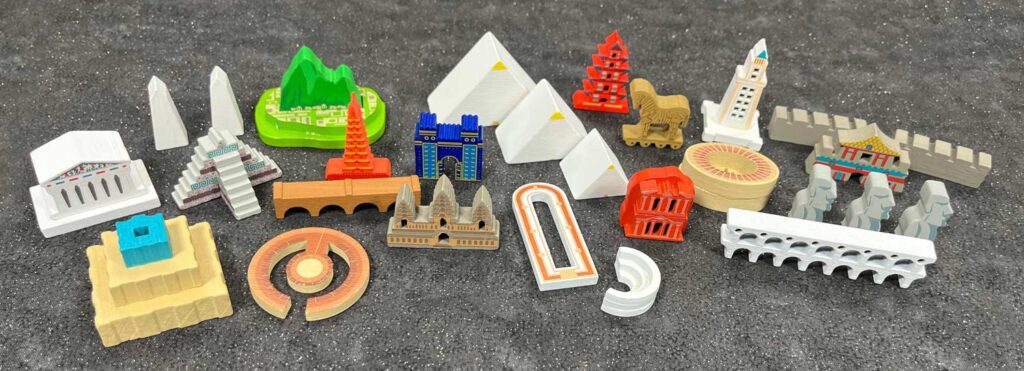
The insert is thoughtfully constructed, with spaces for the small pieces, then concentric nested layers allowing for the player resources track boards, and then the map boards. The only downside is that there’s not much room in the box for the inevitable expansions. Hint hint!
The rulebook is top-notch. In almost every case where we had a question, we found a clearly stated and unambiguous answer, usually with very little time spent looking. There are many full-color examples of placement rules, actions, and board state. There’s even a brief history of each of the monuments at the back of the book. This is a rulebook that other rulebooks could learn from.
But more importantly, World Wonders is a blast to play.
It’s a great spatial puzzle with just enough of the unknown that you can’t plan out every turn. It requires the ability to pivot when Aunt Nancy takes the building tile you were hoping to pick up. So instead you decide to pick up the last road piece, which derails your sister Robin’s turn, and so on.
And I didn’t even talk about the Advanced Play cards, a deck that provides unique end game scoring opportunities. Should you want to add these in, just shuffle the deck, lay out three, and follow the rules to earn points.
There’s also a solo option, should that interest you.
Before I finish, let me call out two flaws in what I’d consider to be an otherwise perfect game. In every game, at least one player misplaced a road tile—having it come out of a building tile instead of touching a road or tower. Because you can put a building tile next to a road, it should follow that you can put a road next to a building. But we were able to overcome it eventually by having everyone keep an eye on other player’s boards to make sure they were following the placement rules.
The other comment isn’t a flaw per se, but more one of perception. Most monuments are only worth a single point. That seems underwhelming when you might spend many turns preparing to acquire a monument. And in some cases you might be forced to cover up a natural resource space in order to place the wonder, which means that you lost a point only to gain a point. That feels out of balance.
World Wonders is excellent, and I can’t wait to play it again. More importantly, I can’t wait to see what sorts of expansion content we might see. Canals, bringing water from a lake or river to where you need it? Additional advanced scoring cards? Even more wonders? The sky’s the limit, folks. Thankfully the publisher is already at work on an expansion, which will likely be available at the end of the year.
Now I just need more room in the box.


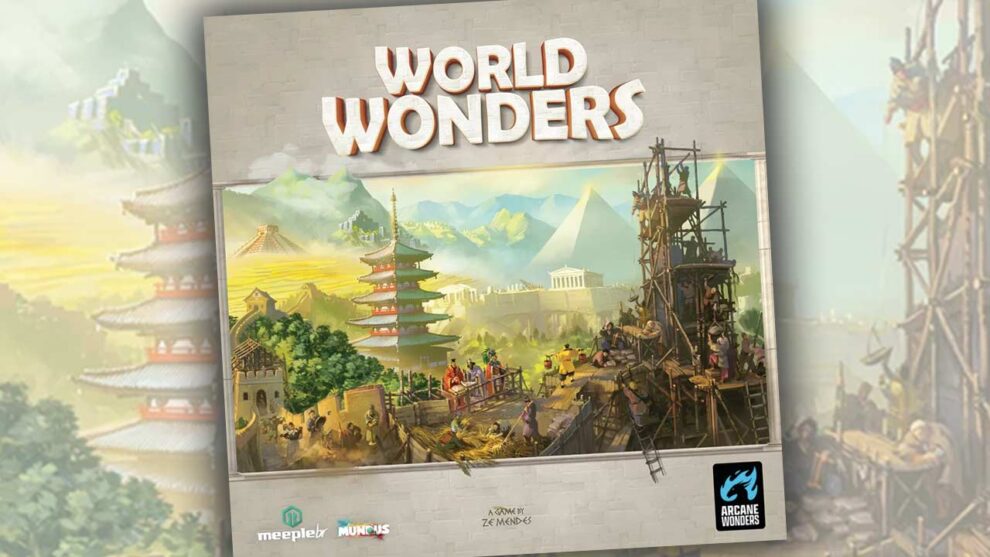




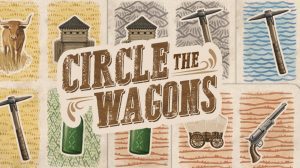




Looking at the photo of your final game board, I would ask. Have you played it correctly? From my understanding, I don’t think it is correct that you have both blue and green building tiles at the bottom of the board, since they can only be build adjacent to a road (or other same color building tile), and the sidewalk along the bottom of the board does not count as a road.
Can you confirm?
Yep, I realized that after writing the review. I was under the impression that the entire bottom was considered a road.